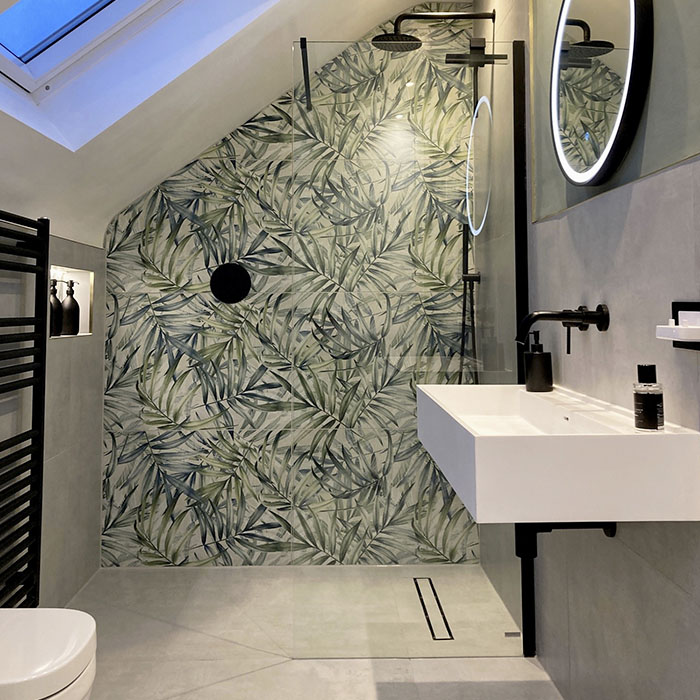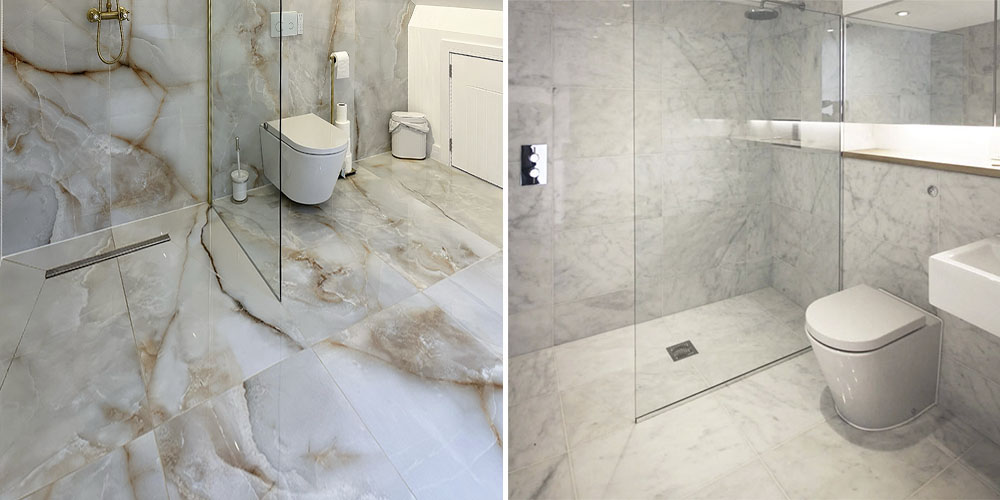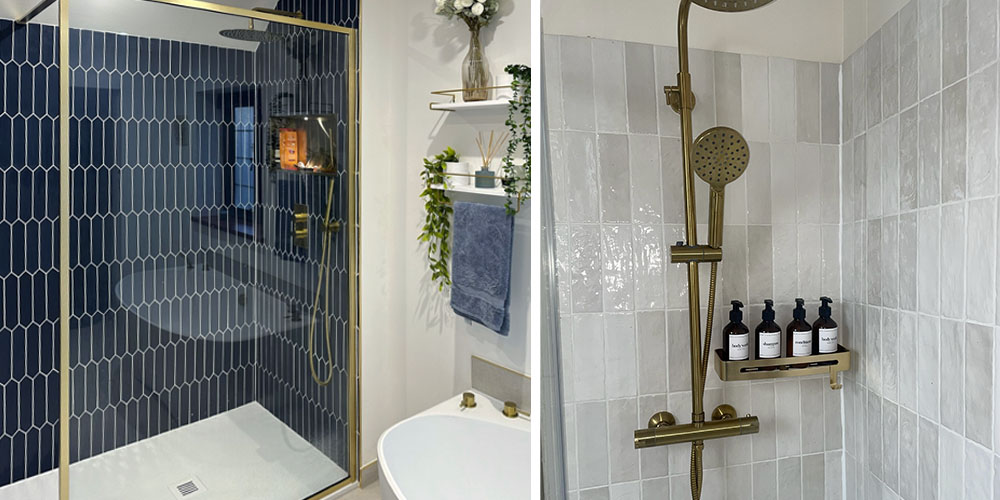When it comes to creating luxurious washrooms and bathroom spaces, there are few options that are more elegant and sought after than wet rooms. Offering a more spacious and open feel than traditional bathrooms, wet rooms are the perfect addition to any home seeking a spa-like aesthetic and sleek relaxation space when getting ready for the day.
If you’re thinking about how to install a wet room in your own home, the initial key question you’re going to need to consider is what tiles you want to use, and how you install them.
So, to see if a tiled wet room is right for your home, we’ll provide a breakdown of what a wet room is, the best tiles for a wet room floor and walls, and if wet rooms add more value to your home than a typical bathroom.

Our Tropical Jungle Patterned Tiles create a stunning feature in this beautiful modern wet room
What is a wet room?
For those unfamiliar with the term, let’s first clarify exactly what a wet room is. A wet room is an entirely waterproofed bathroom, with a walk-in shower set at the same level as the rest of the floor and separate from the bath.
This means that your shower space, walls, and floor are all sealed to prevent any water from escaping and damaging your home, ensuring the water can evaporate, drain out through your shower, or be pulled outside via an extractor fan.
As a result, your bathroom takes on a similar aesthetic to a spa or steam room while offering a far more open space.
What are the best tiles for a wet room floor and wall?
Now we’ve clarified what a wet room is, let’s look at what type of tiles work best in this sort of space. Naturally, you have many material and style options to choose from, such as whether to go with a porcelain design for durability and easier maintenance, or natural stone tiles for better grip and an outdoor feel.
However, while the latter certainly requires some thought, perhaps the main tile consideration to make when tiling a wet room floor and walls, is whether you plan to use large tiles or smaller metro tiles. Both have their pros and cons, and you should plan which you intend to use well before you begin the tiling process.
Below is a breakdown of what both tile types can offer:
Large tiles
Although they can be more expensive, large format bathroom tiles excel in a number of ways. For one thing, they provide more of a clean, seamless look, needing fewer grout lines, which in turn makes for a visually cleaner, uninterrupted surface.
On top of this, their larger size can make any space feel that much wider and open, which is exactly what you want in a wet room. Add to this their easy maintenance and minimalist feel and they can make cleaning your wet room a breeze.

Left: Onyx Natural Polished Porcelain, Right: Ibiza Bianco Honed Marble
Metro tiles
Busier yet arguably more versatile than larger tiles, there are still plenty of reasons why you might want to opt for the metro tile design instead.
Metro tiles look great in both modern and traditional styles, offering limitless creative potential. You can play with laying patterns, colour combinations and come in a range of finishes that can reflect your wet room’s light, helping to increase that sense of natural openness.
However, they can be more of a fiddle to install. And not all metro tiles are suitable for use on floors, so if you desire a seamless wall and floor tile look, larger tiles may be the optimum choice.

Left: Nautilus Navy Metro Tiles, Right: Windsor Pearl Metro Tiles
How to create a wet room
Now that you know what tiles you intend to use, it’s time to think about how to install a wet room and begin the tiling process. As a wet room is complex to build and requires expert knowledge, we’d suggest getting the help of a trained professional for the main installation, but there’s no reason you can’t do the tiling yourself.
So, to get started, here are our steps for how to tile a wet room floor and walls:
1. Measure your space – as with any building project, the first thing you’ll want to do when it comes to how to create a wet room is to work with your installer to measure your space. That way, you’ll know how many tiles you need to cover the room.
2. Decide on layout – once you have your measurements, the next step is to settle on your room’s layout. Where you place your shower, bath, and other bathroom essentials will determine how you do your tiling dry run, and make clear what sorts of tiles need to go where and what cuts you might need to make.
3. Perform a dry run – before beginning any tiling project, it’s vital that you do a dry run to ensure you know where and how your tiles are being laid out. For more information on how to do this, read our blog on where is best to start installing tiles.
4. Tile your room – with the dry run done, it’s time to start tiling. Whether you start with the room’s walls or floors is up to you, but either way, you should take your time doing this to get it right. For information on exactly how to tile a room, take a look at our tile installation advice section.
5. Clean your space – once all the tiling is done, be sure to clean your space and wipe away any dirt before grouting and sealing your tiles for that seamless sparkling look.
And that’s it, tiling a wet room floor and walls is really that easy! Of course, if you’ve read our advice articles on the tiling process and feel you could use some help, don’t hesitate to call a reputable tiler to lend you a hand.
Is a wet room better than a regular bathroom?
You should now have a good idea on whether a wet room is right for you, or not. If you're still deciding between a wet room and a regular bathroom, it’s ultimately dependant on your personal preferences and the suitability of the rooms in your home. After all, what’s right for one home may be different to another.
However, to give you a little bit more insight between the two designs, here’s a breakdown looking at three key areas to consider when deciding between a wet room or a standard bathroom:
1. Practical differences
A wet room provides a lot more flexibility when it comes to washroom layout, amenities, and what you can include in the space. It can also make a smaller space feel larger, as they’re designed to be more open plan.
On top of this, having your shower separate means reduced cleaning, as you won’t have to touch your bath with a cloth if you haven’t used it, and the shower design itself lends to easy draining and minimal staining.
2. Installation price
However, while wet rooms are more flexible overall, this also means they tend to be more expensive to install and heat, especially if you choose to operate such a room with underfloor heating.
Unlike a standard bathroom, you’ll need to waterproof your wet room entirely, and install a new drainage system for the shower. Therefore, it’s certainly can be more expensive to have a wet room.
3. Added value
Last, but not least, wet rooms do tend to add more value to your home, in some cases up to 5% when done right. So, if you really want to increase your home’s value before you move, then installing a wet room may be worth the cost.
And there you have it – you should now know everything you need to about tiling a wet room’s walls and floor. Of course, if you’re still unsure about which tiles you want to use, then you should get in touch with our team of experts today. Don’t forget to browse our tile advice section as well for more articles like this one – including how to choose bathroom tiles.

